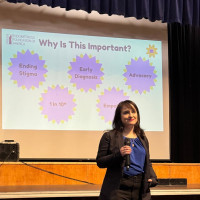Endometriosis Foundation of America
Medical Conference – 2012
Endometriosis is Not a Benign Disease
Linda Griffith, PhD
This is something a little bit different from what Dr. Seckin requested. We saw each other at the AAGL meeting in November. I want talk about some data that we have been quite ____to try to reverse ____networks in the peritoneal cavity and endometriosis and use combinations and computation methods with experimental methods to try to gain insight into networks.
So we work at MIT. I am in the biological engineering department and this project got started because Keith Isaacson, who is a surgeon many of you probably know at MGH and Newton Wellesley, had been very interested in developing a lot of tools for surgery but frustrated that he just keeps operating on the same patients over and over. I ran into him, there is a small community in Boston of people who get together around engineering and surgery and he said, “You really should work on endometriosis from the biology side”. So we pulled together a group of people at MIT and we have been working with him for the past two years to try to bring some tissue engineering and systems biology approaches into this very, very difficult problem. I have gained enormous appreciation for the complexity of the disease through this conference every year and through other clinical meetings I have started to go to.
As we know, there are documented many, many kinds of immune dysregulations in women who have endometriosis. If you look at both the endometrium and the peritoneal cavity, and other facets even of the systemic immune system, there are documented individual dysregulations in terms of increased complement secretion, differences in cell mediated immunity, increasing angiogenesis, neurogenesis and on and on. There are lots known about molecules as well as phenotypes associated with inflammation in this disease. Yet, it is still complicated to stratify patients according to particular facets of dysregulation and particularly to both clinically manage the disease and to gain insight into biologies.
A particular interest that we have is trying to look at the landscape of all these different kinds of high-throughput data acquisition methods that are collectively omics from DNA sequencing, transcriptomics, proteomics of various kinds, both identity and protein modifications, lipidomics and metabolomics all these together - there is enormous data coming out that are being generating databases that in many case are now on the web and in many cases actually well curated that provide a basis for hopefully linking up networks of cross-talk between different immune cells in disease states. What we are hoping to do is use selective measurements that we do combine with databases that already exist on patient samples and integrate analyses across these different scales to get some insight into the biology and ultimately help provide elimination on clinical management.
We started with thinking about the cytokine networks in the peritoneal cavity where you see lesions and we would like to know more about what may foster establishment or progressions. This is just a place to start. Looking back over the past 30 years there has been a lot of individual and groups of cytokines described to go up or down in the peritoneal cavity by different groups of investigators – so many cytokines associated with inflammation and growth factors and intragenesis have been noted to change. When you look across the literature, many cytokines, there is consensus that they are up-regulated and some consensus on those that are decreased in patients with disease. Many have not been reported to change at least with the methods we have available to measure. Then there are some where some reports list them as up-regulated or down-regulated and it may be differences in patient population.
Most groups have taken an approach of doing a few measurements and focusing maybe on a particular pathway and then when we have data like that a traditional approach is to build a map of cell interactions and meticulously try to look for interactions both stimulatory and inhibitory between these different cytokine networks – piecing together individual publications and pathways to build a picture of this by very painstaking methods. Often in these kinds of maps you will by necessity have a somewhat coarse-grain description of immune cells that are involved. You may have a description of a macrophage as an M1 macrophage or an M2 macrophage. We need to make these kinds of simplifications when we start to classify things but as we are learning now individual cells have enormous amount of context complexity to how they respond to external cues. If you have a macrophage in one cytokine environment the mix of cytokines, not just one or two, will dictate what that cell secretes. We are stimulated in this work. inspired in part by a study published a couple of years ago by one of our collaborators on the context diversity in just us human macrophage cell line and how different the ¬¬¬¬¬side _____, this is experiments where the cells were cultured and stimulated then with various inflammatory cues and the profiles of cytokines that they secreted under these different stimulations were measured. What you can see is that you have an enormous diversity in the pattern of cytokine secretion. These are 50 different cytokines and the levels shown here. Some of these patterns do correspond to a classic M1 macrophage pattern and some are similar to an M2 but there is a lot of in between.
The point of this is there is a lot of context complexity in how these cells respond. There is also complexity in the temporal response so for example, here you can see a delayed response when you stimulate with certain cytokines and other have a more rapid onset. There is context complexity depending on what cytokines are there. And bringing this more to endometrium there was recently described an analysis of macrophages, residual macrophages involved in the endometrium and going in, and again, taking an approach of asking are these macrophages? Can you really bin them into these two groups? This paper the macrophage, the residual macrophages were sorted according to CD11 expression and then queried, their gene expression profiles were queried, and then the question is, “Well, do these exhibit a classic M1 or M2 signature”? If they did you would expect to see all red and all blue, one of these all red, one of these all blue. In fact, you have very mixed patterns and you see that these have slightly different patterns so again, a lot of degrees of nuance in what you would call a…we have previously binned it according to one profile but now, as we go in, and look more finely you can see that there is enormous diversity even in things that have been together and you cannot really bin them in just M1 or M2.
This is also true in their patterns of cytokine expression so when you stimulate macrophages they can secrete. One concept is they secrete either pro-inflammatory or anti-inflammatory cytokines but in fact macrophages from both of these groups can secrete both pro and anti–inflammatories. So, the picture is not so simple and we would like to be able to make more sense out of the complexity that exists in the peritoneal cavity, where we know now from these examples, that there is an enormous amount of context complexity to what a macrophage can do when it is in an environment with different stimuli.
So the approach we have been taking is to start, again with the peritoneal cavity and collect peritoneal fluid from patients. Prepare it and analyze 50 cytokines in the peritoneal fluid using a high throughput multiplex amino B assay. In the study we used a Bio-Rad kit that had 50 cytokines and of the 50 that the kit has 37 of them overlapped with those published studies I showed you earlier. Then there are 13 that had not really previously been investigated. There is no significance to the fact that this is 13 and that is 13. It is just the way it worked out.
In the study we used patients from the practice of Dr. Keith Isaacson and his partner Stephanie Morris. The criteria that we used are shown here. The key thing is we have four groups. We have the controls and then patients with minimal to mild disease, moderate to severe, and then a lot of patients who are on progesterone therapy so we decided to include them as a group who had been treated. When we did these studies we analyzed the cytokines and again, this was the basis. When we got the data we found that there were 13 cytokines that actually….again, this was a coincidence, 13 profiles that happened to be significantly different among the patients. Here are the heat maps, so each of these columns is an individual patient. Here are the bins of the disease state and then these are the individual cytokines and the significance with which they change. When we look at all these data, out of this we find consensus with previously published work on these cytokines, and then these cytokines have significant differences that had not been previously reported.
In particular, we can see that the G-CSF levels are up and LIF is down, the SCF is down and these are the data for the individual patients. There are some correlations with disease state and the progestins look more like the controls. We can take these data. You can go back into this immunological network and say, “Well, we know that stem cell factor and LIF are involved in maintenance of stem cell compartments and some other things, so we can try to start putting these back in to a network on an individual basis”. We are doing that. There may be more information we can get by combining the analyses we have done with larger databases of secretion profiles of cytokines that have been developed by others. The approach that we are now taking is to say that we have got data on all of these multiplex cytokines, 50 cytokines in the peritoneal cavity and ones that go up and ones that go down. Could we use this with databases that would let us infer from the profiles what cells may be present and active in the peritoneal cavity. Even without measuring all the cells, because we may not have markers for even all the expression states available to us, can we go back now and infer something about the cell populations that are present based on what they secreted into the peritoneal fluid. The way to do that is you have got to have somewhere an expression profile database, so somewhere, a database where people have annotated “here is a secretion profile based on these descriptors of a cell”. You can have as crudely binned as M1 M2 macrophages but you could go further and further and finer and finer descriptors based on surface markers. These databases exist and I will show you the ones we used in a moment. These databases already exist from being built by a number of genome centers around the world and so you have these databases and you can go in and say that we have our cytokines, can we map that onto the database. So okay, this cell has a certain expression profile and this cell has a different one. Can we now say given this expression profile it maps onto it maps very well onto the expression profile for this cell, and weakly onto this one, because all the up-regulated cytokines these are things this guy secretes, this guy secretes fewer of them at a lower level, and this guy, kind of, it is mixed. There you have got it secrete some of these that we have and some not, and this one secretes lowly of the ones that we have at low abundance, or the ones that this guy secretes. You would say it is strongly positive that this cell would be there, maybe this one. This one is mixed and this cell is likely depleted.
You can take this kind of data and through mathematical algorithms go back and rank the phenotypes and try to predict what cell populations would be most enriched and most depleted in the medium.
In order to do this you need to have a …and that is sort of like if you imagine you were at a cocktail party or there is a cocktail party and there are senators there and actresses and you know something about the way they all…the kinds of language that they use. You want to infer who is at the party just by hearing snippets of conversation. You have past histories of the things these individual people normally say in conversation, you could maybe by just overhearing conversation at the cocktail party back calculate who was at the party.
These expression profile databases are being very well annotated by a number of groups and so the ideas that you have your hematopoeitic cells, your immune cells and you separate them according to markers with flow cytometry or other methods, and then go in and look at the expression profile. So you do a very fine sorting of the cells, measure the expression profile for…and there are two databases of human and a database of mouse. The database of mouse has a lot more fine grained profiles because…there are a lot more fine grain profiles for the mouse. You go in and you build these expression profile databases where you have gradation of cells across the whole spectrum. So you have your markers that define these different cell types as finely as you want and then you measure what they secrete. That is the link for us. We can now query the databases that have linked an expression profile to a particular cell type and map it onto our data. When we do that here is our endometriosis signature from the severe patients and we now query it against the database and this is the particular database for this analysis. What it ranks is the cells that should be…that we would infer are present. This is the rank list. These are enriched and these are depleted and this corresponds very well with what has already been reported for the nature of cells. This is a proof of concept in a way that this method will give us data that makes sense even with this database.
We can go in now with a more finely ranked database profile and go into that database and ask about specific cell populations. The macrophage specific profiles can again be very, very finely graded to not just macrophage but macrophages from different parts of the body or from different tissue systems. When we query our database against our expression profiles against the database of macrophages what emerges as most strongly enriched…and these are just two different experiments that were done on peritoneal macrophages, so these are both showing up as positive in our sample and then rank this down. This again is consistent with previously reported literature and so gives us some insight that we can start to, if we have, even more finely tuned expression profiles go back and query the databases. Where we are headed right now with this is everything we have done so far is using published values of expression profiles from macrophages. At this stage we are now going back in and doing some of these measurements ourselves now that we have more guidance of which…now that we have more guidance on the presence of these cells we are going back in and looking and trying to see if the expression profiles that we get from individual cells in the peritoneal cavity match up with those here.
What we can say to summarize this is that the picture of course is very, very complex. We are trying to build a way to appreciate the complexity but use these high throughput and database methods to appreciate that there is more complexity to immunity than just an M1 or M2 macrophage and that we can start to bin things very finely. Maybe this will let us build more stratification into patients. Here we found, in this particular study, new cytokine regulations associated with the severe disease state, and getting a protocol or framework together that lets us start to infer what cells may be there based on just measuring the cytokine with this high throughput meshes, and in fact found our data predicted that these were consistent with what has been in the literature.
That is what I want to finish with today. This has been a work – again, a joint collaboration between MIT and Harvard Medical School with Keith Isaacson. I look forward to the discussions today.










